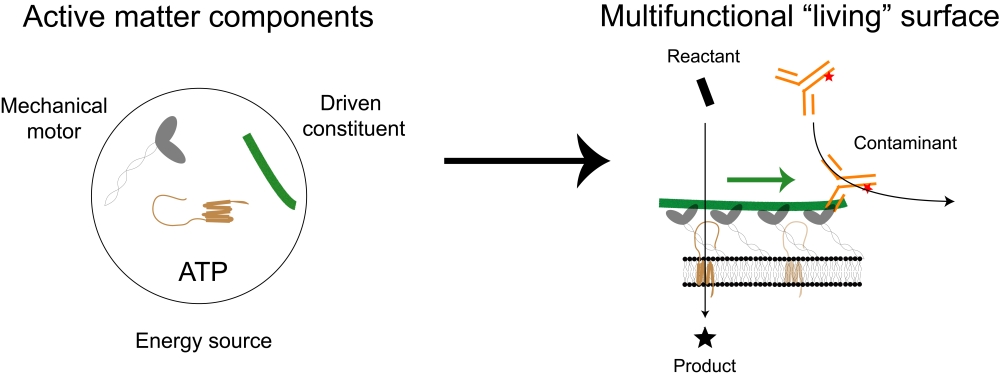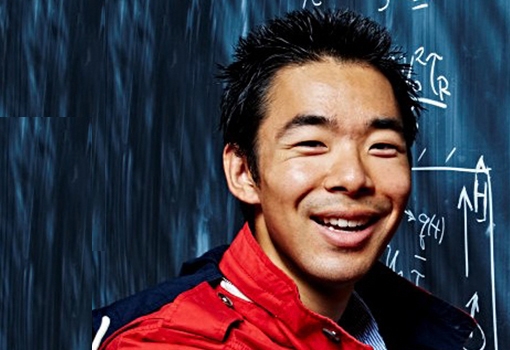Through the magic of ‘active matter’, matter that converts chemical energy into mechanical work to drive emergent properties, biology solves a myriad of seemingly impossible physical challenges. Using active-matter surfaces, for example, our lungs clear an astronomically large number of particulate contaminants that accompany each of the ten thousand liters of air we respire every day, thus ensuring that the lung’s gas exchange surfaces remain functional.
Active matter is of interest to scientists and engineers, like Sho Takatori, an assistant professor of chemical engineering at UC Santa Barbara, because it operates out of thermodynamic equilibrium, taking energy from its environment and using it to move or do work. Takatori and his research group are working to achieve a deeper understanding of active matter, studying how it generates internal forces to control physical and chemical processes. That fundamental knowledge of the dynamics and unique properties of active matter may enable the design of synthetic materials with tunable properties, like the gas exchange and self-cleaning surfaces in our lungs.
“Most engineered surfaces are designed to perform only a single task, like gas exchange or chemical catalysis. And they often have a chronic problem of surface contamination that clogs and deactivates the surface,” explained Takatori. “My lab envisions the development of multifunctional surfaces that enable the simultaneous operation of molecular sensing, recognition, and catalysis. Active matter will play a central role in our mission.”
In support of his leading-edge study of active matter, Takatori has received a prestigious Packard Fellowship for Science and Engineering from The David and Lucile Packard Foundation. Each Packard Fellow receives $875,000 over five years to “take creative approaches to their research, dare to think big, and follow new ideas wherever they lead.” Since its creation in 1988, the Packard Foundation has awarded nearly $500 million to support more than 680 scientists and engineers. Packard Fellows have gone on to receive major awards and recognitions, including Nobel Prizes, Fields Medals, and elections to the National Academy of Engineering, Sciences, and Medicine.
“I am extremely honored and grateful to join this prestigious group of scientists and engineers as a Packard Fellow,” said Takatori, who earned his PhD in chemical engineering from the California Institute of Technology. “Many scientists and engineers who I have respected and admired since I was a PhD student have been Packard Fellows. Their accomplishments have inspired me to dream, which is why this fellowship is especially meaningful to me. The funding will also allow my lab to take creative approaches to high-risk, high-reward projects.”
Takatori is one of only twenty early-career scientists and engineers from across the country who were named to this year’s class of Packard Fellows.
“The College of Engineering is tremendously proud of Professor Takatori for receiving a Packard Fellowship, the largest non-governmental fellowship and one of the most prestigious early-career awards,” said Tresa Pollock, the interim dean of the College of Engineering and Alcoa Distinguished Professor of Materials. “He has already established himself as a leader in the fields of active matter and cell membrane engineering, and this recognition allows him to push the boundaries of discovery even further to improve our quality of life.”
In his project, Takatori seeks to use basic active-matter components — mechanical motor, driven constituent, and energy source — to engineer synthetic surfaces that actuate multifunctional properties.
“Our goal is to direct the flow of matter by orchestrating these ‘living’ molecules found within biological systems, guided by new fluid mechanics models and advanced computations,” said Takatori.
In order to transform their vision into reality, his group must overcome key challenges in the fields of fluid mechanics and surface science, which is the study of the physical and chemical phenomena that occur at the interface of two phases. A major goal is generating surface flows in the absence of any externally imposed force, a grand challenge in fluid mechanics. In most systems, like water flowing through a pipe, an externally imposed pressure drop is required to create flow and movement in the system. Takatori wants to create internal forces to actuate surface flows by directing active matter, which can be used to control the transport of molecules on surfaces. Possible applications for such a technology include sensors that can detect the presence of molecular species in the fluid, surfaces that instinctively self-assemble in a specific geometry, and catalytic surfaces that increase the rate of chemical reactions in the system.
“Our new theoretical framework is the key enabling breakthrough that will allow us to predict and design nonequilibrium active matter,” said Takatori. “This is significant because existing textbook theories often fail to predict the behavior of materials driven out of equilibrium, like batteries, biological tissues, and other systems that dynamically change with time and/or space. Active matter serves as a good model system to advance new theories that may be applied to a variety of chemical and physical systems.”
Takatori said that his research group possesses the ability to complete this high-risk, high-reward project by combining theory, simulation, and experiments to control and design active-matter surfaces with desired properties.
“The successful realization of this technology would generate tunable, living surfaces that combine the dynamic programmability of active matter and the molecular specificity of biological membranes,” he said. “Our hope is that this project will lead to the design of multifunctional surfaces that can perform sensing and communication in ways that have never been achieved.”
Takatori is the fourth Packard Fellow among the Chemical Engineering Department’s eighteen faculty members, an indication, he said, of the high-quality research and teaching that takes place within the department and university.
“Packard Fellows are dared to think big, explore new frontiers, and follow uncharted paths that may lead to groundbreaking discoveries,” said Takatori. “The fact that more than twenty percent of our faculty are recipients is one of the many testaments to the creative science and engineering that the faculty direct. It also displays the strength and innovativeness of our department’s exceptionally talented students and postdoctoral researchers who take off with exciting, out-of-the-box ideas.”
“We are thrilled that the David and Lucile Packard Foundation recognizes and supports the high-impact potential of Professor Takatori’s research,” said Rachel Segalman, chair of the Chemical Engineering Department. “This award affords him the opportunity to take risks in pursuit of scientific breakthroughs that would improve people’s lives and revolutionize everything from medicine to robotics.”
Takatori also expressed gratitude to the graduate students, faculty, and staff in the Chemical Engineering Department, and to the people who have mentored and supported him over the years.
“I would like to thank the members of my research group for providing me with a continuous source of scientific and personal inspiration,” he said. “I also want to acknowledge Rachel Segalman, the chair of my department, John Brady, my PhD advisor at Caltech, Daniel Fletcher, my postdoc advisor at UC Berkeley, and Eric Shaqfeh, my scientific mentor at Stanford. They have all been extremely instrumental in my early-career development.”

Caption: 2022 Packard Fellow Sho Takatori combines theory and experiment to design multifunctional, "living" materials by orchestrating active matter components found in biological systems. New fluid mechanics frameworks will be developed to engineer materials that can actuate molecular recognition, sensing, and chemical reactions.

2022 Packard Fellow Sho Takatori, an assistant professor chemical engineering
